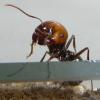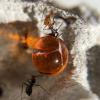I really thought my Pogonomyrmex colony was on the way out. The newest calllows were all male for about two weeks. I thought that either the queen had run out of sperm, or maybe her ability to fertilize eggs had faltered... (Since I couldn't find her for much of that time I also wondered if the workers were trying to lay eggs, but could not determine if this is possible with this species.)
Well today I noticed some young callows who were regular female workers! The spat of boys seems to be over and the queen might be going back to making workers and fertilizing her eggs. I'm hopeful this means the colony won't die off. It's only two years old and doing just fine otherwise.
The things is... this has happened before with this queen... though not as dramatically. Last summer I found a *queen* (so a fertilized egg but with too much food? why would they raise just one queen?) then later I found two males ... I saved these in my pinning box since I thought it was neat to have all of the "morphs" of this species.
But this time it was like 20 or 30 males! No queens. I think... maybe their sisters ate them after awhile? Since I never saw them in the outworld and now there are only a few left as the colony gets back to normal.
What the heck is going on with this colony? I feed them mostly grass seeds, but do give an insect every other week which they seem to like. They have a large outworld and two plate glass "sandwich" sand nests to live in. There are around 500 workers in this colony, it's very lively.
- Formiculture.com
- Forums
- Gallery
- Members
- Member Map
- Chat


















